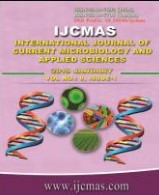


 National Academy of Agricultural Sciences (NAAS)
National Academy of Agricultural Sciences (NAAS)

|
PRINT ISSN : 2319-7692
Online ISSN : 2319-7706 Issues : 12 per year Publisher : Excellent Publishers Email : editorijcmas@gmail.com / submit@ijcmas.com Editor-in-chief: Dr.M.Prakash Index Copernicus ICV 2018: 95.39 NAAS RATING 2020: 5.38 |
Bacterial wilt caused by Ralstonia solanacearum (Smith) Yabuuchi is one of the most destructive diseases of tomato (Lycopersicum esculentum), causing accountable losses of about 10-90 per cent. Present investigations on the disease (R. solanacearum) were carried out during 2014-15 to fulfill the objectives defined, at the Department of Plant Pathology, College of Agriculture, VNMKV, Parbhani. A total of 10 organic amendments evaluated (pot culture) as pre- sowing soil applications were found effective against R. solanacearum. However, significantly highest seed germination was recorded with vermicompost (76.50 %), followed by karanj cake (71.74 %), neem seed cake (66.75 %) and compost (61.67%); whereas, significantly highest reduction in average incidence (PEM and wilt ) was recorded with vermicompost (60.66%), followed by karanj cake (53.74%), neem seed cake (46.70 %) and compost (41.33%). Under artificial epiphytotic conditions (root zone drenching method), all the 14 tomato entries evaluated exhibited different reactions against R. solanacearum. However, six entries (Tom-21, Tom-4, Tom-17, Tom-13, S-22 and PKM-1) were moderately resistant with average wilt incidence in the range of 25.28 to 33.25 per cent; four entries (Tom-15, Tom-11, Tom-27 and Tom-7) were moderately susceptible with average wilt incidence in the range of 47.81 to 52.46 per cent and four entries (Tom-8, Tom-18, Tom-2 and Pusa Ruby) were susceptible with average wilt incidence in the range of 61.13–78.50 per cent.
 |
 |
 |
 |
 |